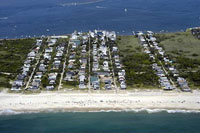Endangered
piping plovers enjoy a baby boom this summer in Rockaway
Twelve nesting pairs of the endangered birds successfully raised
about 25 fledglings this year — five times the 2013 amount.
BY Lisa L. Colangelo
NEW YORK DAILY NEWS
Sunday, August 10, 2014, 2:00 AM

Victor Yin/NYC Parks NYC Park Rangers and seasonal
workers kept an eye on piping plovers this summer in Rockaway. The tiny shore
birds are endangered.
There's
been a baby boom among Rockaway’s piping plovers.
Twelve
nesting pairs of the endangered birds successfully raised about 25 fledglings
this year — five times the 2013 amount.
The
spike has left conservationists scratching their heads after only five chicks
survived to fly south for the winter last year.
“There
is a huge difference between last year and this year, but we can’t say for sure
what allowed that to happen,” said city Park Ranger Brooke Skelly, who monitors
the plump, sparrow-sized birds with three other team members.
The
sand-colored, federally-protected piping plover — named for its plaintive,
bell-like whistle — builds its nest in the sand near the shoreline every year
from March until the end of August between Beach 38th St. and Beach 56th St.
The
recent dredging along the beach to help build up the hurricane-ravaged
shoreline could have given gulls and crows another source of food - sparing the
plover chicks from predators.
“We
did notice there was a huge population of gulls feeding on whatever they pulled
out of the ocean,” said Skelly.
 Debbie
Egan-Chin/New York Daily News
Debbie
Egan-Chin/New York Daily News
Piping plover season was
especially successful in Rockaway this year with almost 25 successful
fledglings. The tiny, endangered shore birds are required by the federal and
state governments to have a protected habitat.
Protecting
the plovers along the Eastern seaboard, including Rockaway, has drawn grumbles
from some who resent seeing large sections of beach roped off and manpower
dedicated to keeping watch over the birds.
The
National Park Service monitors plovers on their stretch of beach on the western
end of the peninsula.
Federal
and state authorities mandate special accommodations for the plovers, which
were almost driven into extinction decades ago.
“It’s
just part of the whole fragile web of life,” said Don Riepe, who heads the
northeast chapter of the American Littoral Society. “The more species we lose,
the less diversity we have in our environment.”
In
the late 1800s, plover feathers were used to decorate women’s hats. In more
recent years, shoreline development destroyed the habitats suitable for the
birds to breed.
There
are now about 800 breeding pairs, including 200 in New York, according to the state
Department of Conservation.
 Debbie
Egan-Chin/New York Daily News A piping plover is almost
invisible and it blends into the sand in Rockaway. The tiny, endangered
shorebirds enjoyed a successful breeding season this summer.
Debbie
Egan-Chin/New York Daily News A piping plover is almost
invisible and it blends into the sand in Rockaway. The tiny, endangered
shorebirds enjoyed a successful breeding season this summer.
The tiny stout birds, which weigh between one and two ounces and
are about five inches long, also fall prey to stray cats and rats.
Skelly
leads a seasonal plover team of three: Nathan Green, Natalia Quinteros and
Victor Yin. All have experience or have studied wildlife biology.
For
eight hours, seven days a week they watch over the plovers, recording their
activities and maintaining the fences that protect their breeding area.
They
also explain the work to beachgoers who often wonder why the section between
Beach 38 to Beach 56 is off limits.
But
the plovers have fans too, who often ask team members for a status update as
they pass on the boardwalk.
“I
think we can all co-exist with a lot of knowledge and tolerance,” said Riepe.
“There’s enough beach for everyone.”












